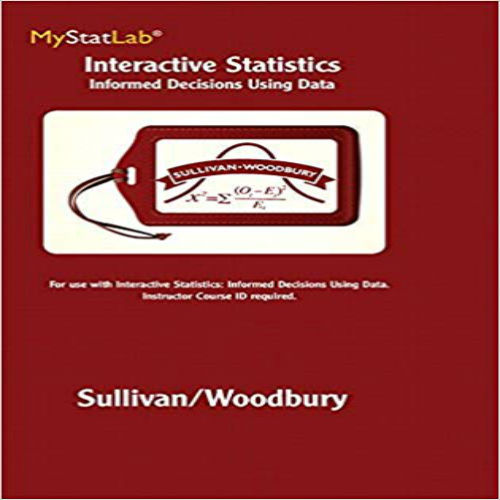Solution Manual for Interactive Statistics Informed Decisions Using Data 1st Edition Sullivan Woodbury 0321782593 9780321782595
$35.00 Original price was: $35.00.$26.50Current price is: $26.50.
Click Icon bellow to Download sample Solution Manual for Interactive Statistics Informed Decisions Using Data 1st Edition Sullivan Woodbury 0321782593 9780321782595
This is completed downloadable of Interactive Statistics Informed Decisions Using Data 1st Edition by Michael Sullivan III, George Woodbury Solution Manual.

Instant download Interactive Statistics Informed Decisions Using Data 1st Edition by Michael Sullivan III, George Woodbury Solution Manual pdf docx epub after payment.
Product Details:
ALERT: Before you purchase, check with your instructor or review your course syllabus to ensure that you select the correct ISBN. Several versions of Pearson’s MyLab & Mastering products exist for each title, including customized versions for individual schools, and registrations are not transferable. In addition, you may need a CourseID, provided by your instructor, to register for and use Pearson’s MyLab & Mastering products.
Language:
ISBN-10: 0321782593
ISBN-13: 978-0321782595
ISBN-13: 9780321782595
author: Michael Sullivan III, George Woodbury
interactive statistics informed decisions using data student access kit
interactive statistics informed decisions using data student access kit 2nd edition
interactive statistics informed decisions using data pdf
Relate Product:
Table of Content:
I: GETTING THE INFORMATION YOU NEED
1. Data Collection
1.1 Introduction to the Practice of Statistics
1.2 Observational Studies versus Designed Experiments
1.3 Simple Random Sampling
1.4 Other Effective Sampling Methods
1.5 Bias in Sampling
1.6 The Design of Experiments
II: DESCRIPTIVE STATISTICS
2. Organizing and Summarizing Data
2.1 Organizing Qualitative Data
2.2 Organizing Quantitative Data: The Popular Displays
2.3 Additional Displays of Quantitative Data
2.4 Graphical Misrepresentations of Data
3. Numerically Summarizing Data
3.1 Measures of Central Tendency
3.2 Measures of Dispersion
3.3 Measures of Central Tendency and Dispersion from Grouped Data
3.4 Measures of Position
3.5 The Five-Number Summary and Boxplots
Chapter Review
Chapter Test
Making an Informed Decision: What Car Should I Buy?
Case Study: Who Was “A Mourner”?
4. Describing the Relation Between Two Variables
4.1 Scatter Diagrams and Correlation
4.2 Least-Squares Regression
4.3 Diagnostics on the Least-Squares Regression Line
4.4 Contingency Tables and Association
III: PROBABILITY AND PROBABILITY DISTRIBUTIONS
5. Probability
5.1 Probability Rules
5.2 The Addition Rule and Complements
5.3 Independence and the Multiplication Rule
5.4 Conditional Probability and the General Multiplication Rule
5.5 Counting Techniques
5.6 Simulation
5.7 Putting It Together: Which Method Do I Use?
6. Discrete Probability Distributions
6.1 Discrete Random Variables
6.2 The Binomial Probability Distribution
6.3 The Poisson Probability Distribution
7. The Normal Probability Distribution
7.1 Properties of the Normal Distribution
7.2 Applications of the Normal Distribution
7.3 Assessing Normality
7.4 The Normal Approximation to the Binomial Probability Distribution
IV: INFERENCE – FROM SAMPLES TO POPULATION
8. Sampling Distributions
8.1 Distribution of the Sample Mean
8.2 Distribution of the Sample Proportion
9. Estimating the Value of a Parameter Using Confidence Intervals
9.1 Estimating a Population Proportion
9.2 Estimating a Population Mean
9.3 Putting It Together: Which Procedure Do I Use?
9.4 Estimating with Bootstrapping
10. Hypothesis Tests Regarding a Parameter
10.1 The Language of Hypothesis Testing
10.2A Hypothesis Tests on a Population Proportion with Simulation
10.2B Hypothesis Tests on a Population Proportion Using the Normal Model
10.3A Using Simulation/Bootstrapping in Hypothesis Tests for a Population Mean
10.3B Hypothesis Tests for a Population Mean
10.4 Putting It Together: Which Procedure Do I Use?
11. Inference on Two Samples
11.1A Using Randomization Techniques to Compare Two Proportions
11.1 Inference about Two Population Proportions: Independent Samples
11.2A Using Bootstrapping to Conduct Inference on Two Dependent Means
11.2 Inference about Two Population Means: Dependent Samples
11.3A Using Randomization Techniques to Compare Two Independent Means
11.3 Inference about Two Population Means: Independent Samples
11.4 Putting It Together: Which Procedure Do I Use?
12. Inference on Categorical Data
12.1 Goodness-of-Fit Test
12.2 Tests for Independence and the Homogeneity of Proportions
12.3 Inference about Two Population Proportions: Dependent Samples
13 Comparing Three or More Means
13.1 Comparing Three or More Means: One-Way Analysis of Variance
13.2 Post-Hoc Tests on One-Way Analysis of Variance
14. Inference of the Least-Squares Regression Model
14.1A Using Randomization Techniques on the Slope of the Least-Squares Regression Line
14.1 Testing the Significance of the Least-Squares Regression Model
14.2 Confidence and Prediction Intervals
People Also Search:
interactive statistics informed decisions using data by sullivan/woodbury
interactive statistics informed decisions using data 2nd edition
interactive statistics informed decisions using data sullivan and woodbury 2nd ed
statistics informed decisions using data 3rd edition





